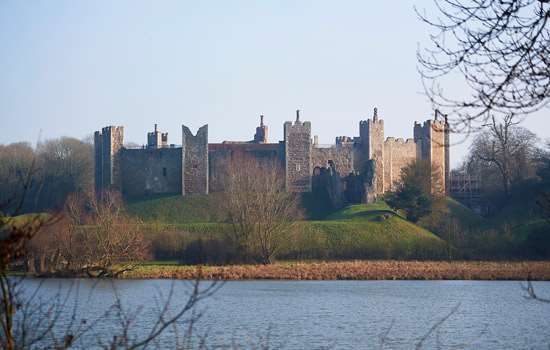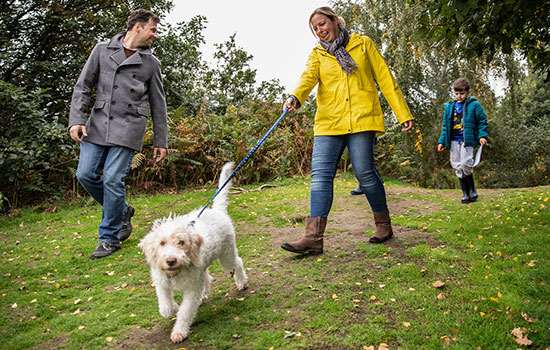Best for 11th century - Richmond Castle, North Yorkshire
Richmond Castle is a wonderful survival from the first decades after the Norman Conquest. Many early castles consisted of earthworks and timber buildings, but a few were built of more permanent materials, and Richmond was one of the finest. The castle was founded around 1071 by Count Alan Rufus of Brittany, shortly after the Conqueror’s ‘harrying of the north’, and took the form of a broad triangle, with an arched gateway at its apex. At the same time, a town was laid out to the north of the castle. Much of the original fabric still survives unchanged. The castle’s north-east flank, where the stone wall is strengthened with two rectangular towers, is substantially the 11th-century construction, including the beautiful Chapel of St Nicholas on the ground floor of Robin Hood’s Tower and the Gold Hole Tower nearer to the river.
What to look for
11th-century castles, when built in stone, are relatively plain: arches are simple and round, and towers are rectangular in plan.
Other great 11th-century castles
The invading Norman army strengthened this massive Roman fort. It later became permanent, with the addition of a stone tower, walls and towers.
Though badly ruined today, Peveril Castle still has sections of stones laid in a herringbone pattern, a feature of late Saxon and early Norman construction.
Visit Richmond CastleBest for 12th century - Dover Castle, Kent
With its magnificent great tower surrounded by two lines of curtain walls, Dover Castle is internationally important as a masterpiece of 12th-century castle design.
The high white cliffs of Dover had seen military emplacements of the Iron Age, the Romans, almost certainly the Anglo-Saxons, and the Normans but it was King Henry II (1154–89) who created one of the mightiest (and most costly) fortresses in Europe. Henry’s works of the 1170s and 80s revolved around a superb great tower. Wrapped around the tower was a curtain wall studded with 10 rectangular towers and two gatehouses, forming an inner enclosure. The king’s greatest innovation was to add a second outer curtain wall, one of the earliest examples of a concentric plan. Little wonder that Dover was one of only two castles to hold out when the French invaded in 1216.
What to look for
The rectangular towers of the inner curtain wall contained loopholes in their flanking walls, allowing crossbowmen to repel anyone attacking. The gateways in the inner curtain wall were protected by towers on either side – a very early example of a pattern that became the norm for the next four centuries.
Other great 12th-century castles
Framlingham has an intact circuit of 12th-century curtain walls with 13 towers.
Contains the ruins of an 1130s castle in which the hall, chapels and chambers were planned around a central courtyard.
Visit Dover CastleBest for 13th century - Beeston Castle, Cheshire
On a high crag dominating the Cheshire plain, Beeston Castle is an outstanding example of the 13th-century trend in castle architecture: to focus on strengthening the perimeter defences, rather than one large tower or keep.
Begun by Ranulf, earl of Chester in the 1220s, Beeston shows the progress of castle design since Dover. Beeston had inner and outer curtain walls, but the towers on the wall and those flanking the gate passage were now D-shaped rather than rectangular. The inner ward lay within a ditch, the source of much of the stone from which the castle was built. The gatehouse was now one of the most important buildings in the castle.
What to look for
The inner curtain wall contains sockets for projecting timber fighting platforms, allowing defenders to drop rocks on to anyone trying to scale the wall.The crossbow loops have fish-tailed bases (‘oillets’) and crosses for the visibility of the crossbowman inside.
Other great 13th-century castles
Goodrich Castle, Herefordshire
Rebuilt in the 1270s as an imposing quadrangular castle. Inside were the Valence family’s sumptuous apartments.
Although architecturally unremarkable for the 1230s and not built for military use, Tintagel reveals how noblemen thought about castles.
Visit Beeston CastleBest for 14th century - Carisbrooke Castle, Isle of Wight
Carisbrooke, located in a strong hilltop position, was fortified by the Anglo-Saxons against Viking raiders – and its buildings show the efforts of successive owners to update its defences, especially the Normans in the 12th century, and Countess Isabella de Fortibus in the 13th. But from the 1330s onwards, wars with the French (now called The Hundred Years’ War) placed the castle in the front line, and a number of additions were made. Most important of these is the imposing gatehouse, with drum towers projecting into the ditch. The lower parts of the towers are fitted with cross-shaped loopholes for crossbowmen. By 1380, Carisbrooke’s armoury had begun to include firearms, and the upper parts of the tower contain keyhole-shaped gunports – some of the earliest surviving examples in England.
What to look for
Don’t miss the fine carving of the fireplaces in the hall and principal chamber of the Constable’s Lodging (now museum) and the gatehouse added to the keep, with its stone vault to minimise the risk of fire.
Other great 14th-century castles
Dunstanburgh Castle, Northumberland
This coastal fortress was built in 1314 by Earl Thomas of Lancaster, to surpass the castles of his cousin, King Edward II.
An example of a sophisticated 14th-century castle.
Visit Carisbrooke CastleBest for 15th century -
Middleham Castle was one of the great powerhouses of late-medieval England, befitting its owners, the Neville family, who owned or controlled much of the north of England.
Middleham had been an important castle since at least the late 12th century, attested to by its mighty rectangular keep, surrounded by a curtain wall of about 1300. But the castle was transformed at the turn of the 15th century by ranges of lodgings all around the enclosure. In their number, the new apartments attest to the size and social complexity of great households, which were becoming increasingly divided according to rank. The ancient keep was also made more comfortable or fashionable in the 15th century, with the raising of the great hall roof and creation of more windows to light the interior. The modernised castle was a fitting home for its most famous occupants, Richard Neville (1428–71) and his ward, the future King Richard III (1452–85), who spent much of his youth there, and was later granted the castle.
What to look for
The relatively large windows, reflecting the care of 15th-century noblemen for their comfort and that of their guests.
Other great 15th-century castles
As well as the usual domestic buildings of a great house, Ashby contains two massive stone towers – a conscious revival of castle keeps.
Baconsthorpe demonstrates the aspirations of a gentry family in the late 15th century.
Visit Middleham CastleBest for 16th century - St Mawes Castle, Cornwall
St Mawes, Cornwall, is the most complete surviving building from a chain of coastal fortresses commissioned by King Henry VIII to protect against French or Spanish invasion.
Observers in the 16th century were happy to call St Mawes a ‘castle’ but it represents something different. This was a structure purely for defence, with no hint of a stylish house inside. And, unlike the monarchs, aristocrats and bishops who lived in medieval castles, captains ranking as knights commanded St Mawes and other forts. Beautifully designed, with a central round tower surrounded by three bastions, St Mawes allowed gunners to command the important anchorage of the Carrick Roads. Embrasures for cannons and pivots for swivel-guns can be seen in various places. But for all its geometric beauty, the castle’s design was soon overtaken by a preference for lower straight walls and pointed bastions on the angles.
What to look for
Carved shields on the exterior walls sit below Latin inscriptions praising Henry VIII and his son Edward, Duke of Cornwall.
Other great 16th-century castles
Kenilworth Castle, Warwickshire
Robert Dudley converted Kenilworth Castle into a palatial residence in the 1570s to entertain Queen Elizabeth I.
Like St Mawes, Walmer Castle was one of Henry VIII’s forts, but was much larger, with four rounded bastions.
Visit St Mawes CastleBest for 17th century - Bolsover Castle, Derbyshire
Bolsover represents a magnificent updating of the castle tradition, by successive generations of the Cavendish family. The Little Castle, built in the early 17th century as a retreat from the family’s main residence at Welbeck, evokes a Norman great tower, though modernised with large windows and a domed lantern tower. William Cavendish, Earl of Newcastle, entertained King Charles I twice here in the 1630s. Fighting for the king in the Civil War, William was exiled from 1644 until 1660, but then returned and added a large Riding House, to indulge his passion for manège, similar to modern dressage.
What to look for
The exotic wall paintings in the Little Castle, which bear complex meanings.
Visit Bolsover Castle


